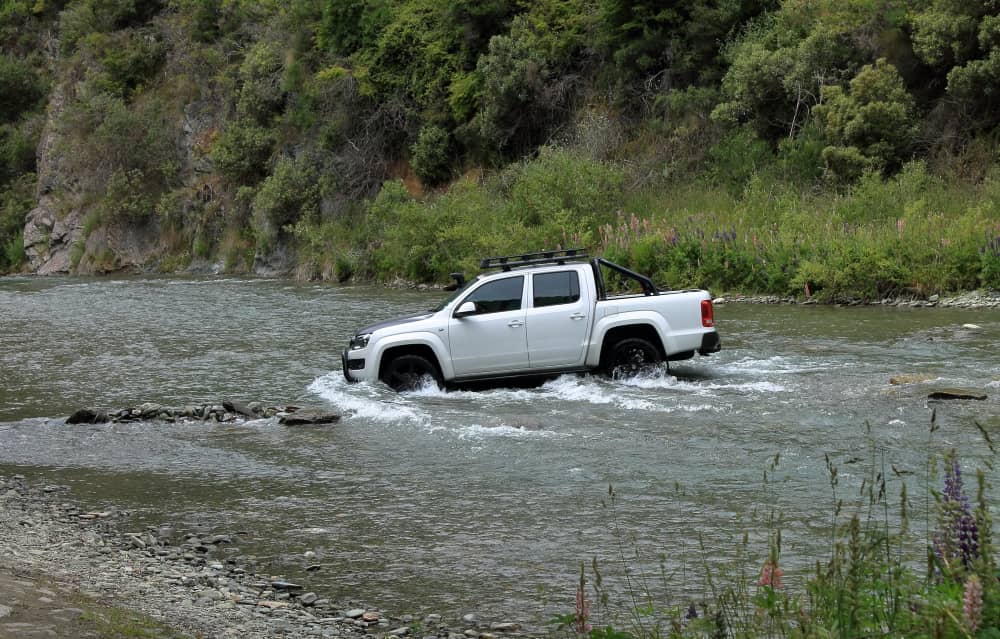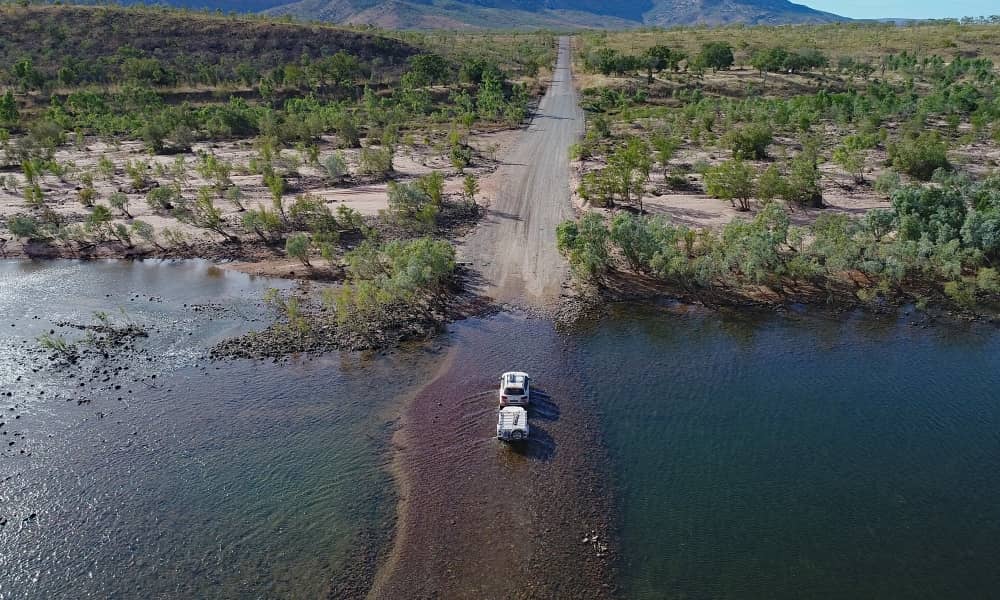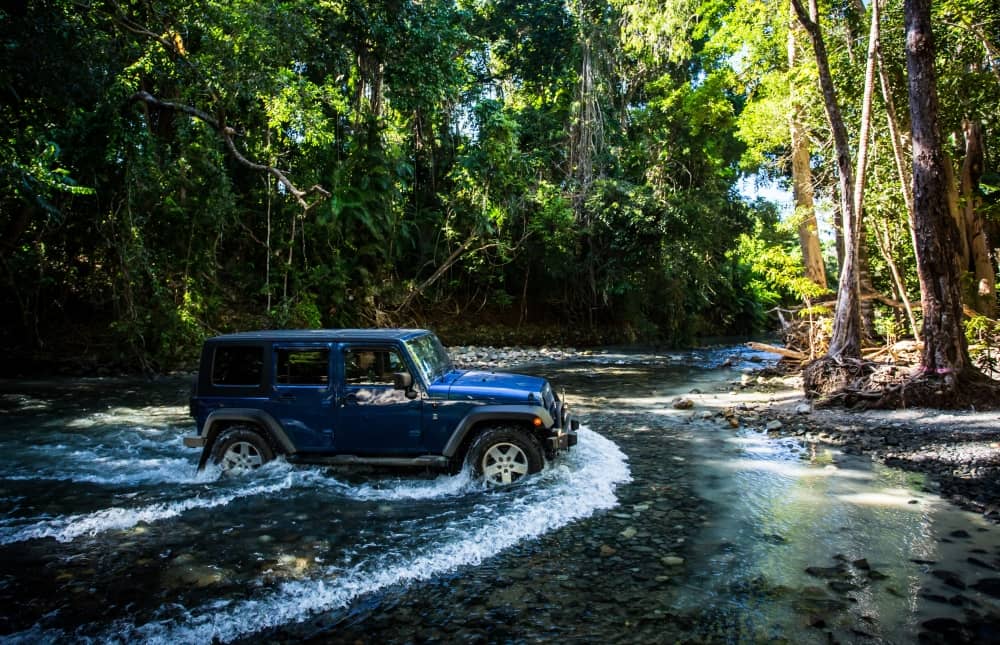There’s no doubt water crossings are one of the most exhilarating aspects of a 4WD adventure. But even for the most experienced off-roaders, water crossings require extensive planning and proper execution to ensure you and your vehicle get across safely.
While it is best to avoid a water crossing if possible, there are ways to make 4×4 river crossing easier and safer.
Here are the best tips for 4×4 water crossing, common issues you may experience, and what to do if you get stuck during a 4×4 water crossing.
10 Driving Tips for a Safe 4×4 Water Crossing
Water crossings can be an absolute blast but they do require serious considerations.
Driving blindly into a water crossing with no preparation is one of the most dangerous mistakes a 4×4 enthusiast can make.
You can easily end up stranded in the muck or facing costly vehicle repairs. Worse, you can be at risk of being swept away completely.
Here are tips for a safe and successful 4×4 water crossing.
1. Know Your 4×4’s Limits and Capabilities
Ask yourself these questions about your 4×4 before a water crossing:
- Does your 4×4 have computers in a vulnerable spot?
- Do you have manual or electric windows?
- What is your vehicle’s maximum wading depth? In most cases, 600mm is the maximum
- Where is your air intake located?
- Where are your 4×4’s transmission breathers and axle located? Does it have extended breathers?
- What parts of your vehicle need to be protected from water?
- Is your vehicle fitted with a snorkel or does it have a raised air intake? If you plan to cross water above your headlights or bumper, you’ll want to have your vehicle fitted with a snorkel or water bra at your local 4WD shop
- Have you kept up to date with your 4WD’s maintenance?
2. Examine the Water Crossing Closely
For any 4×4 water crossing, you’ll need to examine the water closely. You need to know various important factors, including:
- The depth of the water
- The slope of the exit and entry points
- The consistency and type of bottom it is (i.e. rock, sand, mud, gravel, etc.)
- Any drop-offs
- Any hidden obstructions (rocks, logs, etc.)
- How fast the current is moving
- Length of the crossing
If it is possible and safe, walk the crossing yourself before driving through it. This will give you an exact idea of the depth, current, and bottom type, and gives you a chance to locate and remove hidden obstructions. You can also use a branch to help gauge the depth in certain areas or detect objects.
Even if you’ve crossed an area before, it is best to walk it again. The depth may have changed since the last time or there could be a hidden object that wasn’t there during your last crossing.
Use common sense and avoid strong currents, floodwaters, or waters with dangerous wildlife. When in doubt, do not enter the water with yourself or your vehicle.
3. Understand What the Different Bottom Types Mean for Your Crossing
Here’s a look at some of the different bottom types and what they mean for your 4×4 water crossing:
A rocky, solid bottom or compacted gravel bottom often makes for the easiest crossing
Sandy bottoms are usually fairly simple but can spin the wheels in some cases and cause your wheels to sink
Muddy bottoms are the worst and cause the most difficulties, making momentum a key factor in a successful crossing
4. Get the Correct Tyre Pressure
Tyre pressure is one of the most important aspects of a successful 4×4 water crossing. Airing down the tyres properly creates a longer, wider tread to allow for additional grip on the bottom.
If the river bottom is mud or sand, opt for lower tyre pressure (typically around 15 psi). A rocky, slippery bottom requires tyre pressure that can handle a firm base, usually upper teens to low 20s. A firm, compacted gravel bottom can handle slightly higher tyre pressure.
5. Know When to Find a Different Area to Cross
Water that is deeper than your undercarriage and moving fast can pick up your entire vehicle and float you downstream. Not a position you want to be caught in!
Always find the area with the shallowest depth, slowest moving water, and solid bottom. When in doubt, find another area to cross.
Here are some instances that indicate you may be safer crossing in a different area:
- If you notice you sink below your knees when trying to walk across
- If you find it difficult to walk across due to the depth or current
- If the water is deeper than your undercarriage
- If the bottom is particularly muddy or mucky
- If you are attempting to cross floodwaters
6. Have the Proper Recovery Gear
As with any off-roading in the outback, preparation is crucial to a safe, successful trip.
Always have the proper recovery gear with you and hooked up before crossing any body of water. Attempting to attach a snatch strap when your vehicle is taking on water costs you precious time and will lead to unnecessary damage.
Having your recovery gear properly attached and secured beforehand ensures that you are ready to react as quickly as possible if trouble arises.
Before a water crossing, be sure to:
- Install recovery tow bars
- Have tow ropes or snatch straps already hooked up and ready to go
- Have your soft shackles in a convenient spot
- Have rated recovery points installed on the front of your 4×4 (this makes for a smoother recovery and keeps your chassis protected if you needed to be recovered)
- Have your winch unspooled and have the controller attached and ready
- Engage all traction aids
7. Take a Cooldown
Before a 4×4 river crossing, it’s a good idea to stop for a bit and let your vehicle cool down.
Driving into cold water with a hot axle can cause water to get sucked into the hub seals. Oil seals are manufactured to keep oil inside, not necessarily to prevent water from getting in.
Giving your vehicle a chance to cool down also helps ensure that the electric fan or viscous coupling fan doesn’t kick in before or during your crossing.
8. Keep It Smooth and Consistent During 4×4 Water Crossing
Do you know those pictures of vehicles pummeling into a river with a burst of water spraying everywhere? It makes for a great photo, but it’s the last thing you want.
- Calm.
- Smooth.
- Slow.
- Steady.
These are the keys to a successful water crossing.
The goal is to slowly drop the front of your 4×4 into the water and keep a smooth pace. This generates a bow wave at the front of your 4×4 that pushes the water out and away from the vehicle to protect its vulnerable parts and create a clear path.
If you barrel into the water with full force, you’ll spray water everywhere and put your 4×4 at risk of damage.
For manual vehicles, do not switch gears while crossing. Changing gears partway through can cause junk to get sucked up into the clutch. This can decrease your much-needed momentum and put you at risk of getting stuck.
For automatic vehicles, low-range gear (first or second) is often the best way to keep a consistent pace.
Whether you’re in a manual or automatic vehicle, do not stop! Pick a gear, keep it smooth, and stick with it.
Off-road drivers often prefer second gear for water crossings, depending on the water’s speed and depth. First gear is often too slow, with third or fourth gear being too fast.
When entering the water, keep a decent speed. You want enough momentum to get across smoothly but not so much that you spray water all over. Typically, 5 to 10km/h is about the speed you’ll want to aim for.
9. Turn Off the AC
During a 4×4 water crossing, it is recommended to keep your air conditioner turned off. This prevents the condenser from heating up and causing the electric fan to turn on.
10. Be Aware of Other Vehicles
Road rules during a 4×4 water crossing are somewhat of an uncertain area. While there aren’t necessarily clear rules, it is best to pay close attention to other vehicles and proceed with caution.
Never follow another 4×4 too closely during a water crossing. If they get stuck in front of you, you’re going to join them!
Wait for any vehicles ahead of you to get across completely before you follow and communicate with other 4x4s if possible.
What Are The Risks of Crossing Water?
If you can avoid a water crossing, this is your safest choice.
Driving your 4×4 through a river crossing can force water into places it isn’t meant to go. If there’s any sand or salt mixed into the water, it can get stuck in areas and remain damp, leading to corrosion over time.
Even getting a small amount of water in the engine can result in costly repairs, being stranded, or a complete engine rebuild. The electronic components of your 4×4 are also susceptible to water damage.
Whether your 4×4 has a diesel or petrol engine, it can leave you stranded if it ingests too much water. If deep 4×4 water crossings are a regular occurrence for you, be sure to look at raising your air intake point with a snorkel.
Fast-flowing water is especially dangerous for you, any occupants of the vehicle, and your 4×4 itself. Fast currents can sweep your vehicle away.
Floodwater is the most dangerous as the current is fast and unpredictable and the churned, murky waters can hide obstructions. Always avoid floodwaters completely.
A good rule of thumb for any 4×4 water crossing is that if the current is too fast to walk through, it is too dangerous to drive through.
What Do I Do If I Get Stuck Crossing Water?
Go into any water crossing with open windows and unlocked doors to allow for a fast exit if needed.
If you get stuck during a 4×4 river crossing, you hopefully already have an emergency plan in place and know exactly what to do.
Here are tips on what to do if you get stuck during a 4×4 water crossing:
- Avoid making panicked decisions
- If your 4WD is maintaining its position, calmly decide what you will do next
- If needed, climb on the roof
- If you can’t move forward, try reversing the vehicle
- Engine stalled? Attempt a restart immediately to prevent water from entering the exhaust pipe
- If your 4×4 has a diesel engine and it stalls, do not attempt to start it again as the engine will compress water if any water entered the air intake
Checklist After a 4×4 Water Crossing
Even after a successful 4×4 river crossing, there are a few steps to take to ensure your 4WD doesn’t get damaged.
After crossing, you can gently use your brakes to help remove extra water or keep your 4×4 running for a bit before shutting it off for a break.
Did your 4WD sputter during the crossing? Or stall at some point after? Your engine may have gotten water sucked into it. When addressed immediately, it is almost always possible to prevent lasting problems.
If you suspect water intake, give your 4×4 some time to dry and perform these steps to make sure you prevent damage:
- Disconnect the battery
- Check your oil and transmission fluids (it’s easy to tell if these have made contact with water as you’ll notice a milky appearance)
- Check the air filters for moisture (replace them if necessary)
- Remove the spark plugs, rotate your engine’s crank, and check for signs of water on top of the pistons
- Drain a bit of fuel to check if it was exposed to water. If it was, drain the filters, fuel line, and fuel tank completely.
- Check the fuses and replace them if they are damaged
–
Want More Tips for Safe Off-Roading Adventures in Your 4×4?
When it comes to a 4×4 river crossing, if you can stay out of the water, that is the safest choice. However, we know how exciting, and necessary, a 4×4 water crossing can be.
For any 4×4 water crossing, be prepared, know your 4×4, stay level-headed, and have fun!
Are water crossings in your future? Book an appointment with our expert service technicians and we’ll give your 4×4 a thorough inspection to make sure you are set up for success.
As Perth’s 4×4 modification specialists, we’ll let you know your maximum wading depth, point out vulnerable areas, and help you be prepared for a safe, successful water crossing.
For more resources on off-roading, maintenance, and upgrades, check out our blog. Our blog is dedicated to helping 4×4 enthusiasts get the most out of their vehicles and off-roading adventures. As always, contact us anytime with questions or to book an appointment!


